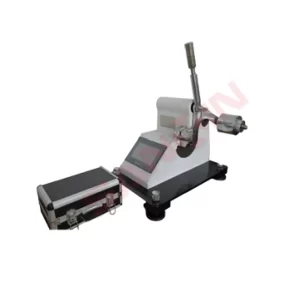Digital Fabric Ripping Meter SX033D

Introduction:
This instrument features a user – friendly interface and is an intelligent device for measuring the tear performance of fabrics. It is mainly used to measure the average tear strength of various woven fabrics and non – woven fabrics with regular tear directions. Meanwhile, it is also applicable to the measurement of tear strength of paper, plastic sheets, electrical tapes, etc.
This instrument does not require a spirit level. It has the function of automatically identifying the horizontal state and can automatically memorize the swing amplitude of the instrument without a sample and relevant parameters of the instrument’s leveling state. Therefore, the horizontal state of the instrument does not affect the accuracy of the test data. Accurate data can be obtained whether the instrument is in a horizontal state or not. This function improves the measurement accuracy, eliminates the need for cumbersome horizontal adjustment, and prevents additional errors caused by accidental changes in the instrument’s position.
This instrument has strong versatility, a wide range of strength testing, and high resolution, which can meet the tear tests of most samples.
For this instrument, the sample is automatically incised, and the pendulum weight is automatically released. After gently touching the “Start” icon, the instrument will automatically complete the test according to the test procedure.
This instrument uses a pneumatic method to clamp the sample. The clamping force is constant, and it has good adaptability to both thick and thin samples, with high reliability.
This instrument can set the gravitational acceleration around the world, making the test results more accurate.
The instrument’s touch – sensitive color LCD screen uses a digital display method to show test information and average values. The test results are printed by a printer, reducing the calculation work and fatigue of operators. The screen brightness is adjustable, and it has a screen – saver function to protect the operator’s eyesight and the screen.
Standards:
GB/T 3917.1 – 2009 Textiles – Tear properties of fabrics – Part 1: Determination of tear force by the single – pendulum method
ISO13937 – 1 – 2000 Textiles – Tear properties of fabrics – Part 1: Determination of tear force using the single – pendulum method (Elmendorf)
EN ISO13937 – 1 – 2000 Textiles – Tear properties of fabrics – Part 1: Determination of tear force using the single – pendulum method (Elmendorf)
BS EN ISO13937 – 1 – 2000 Textiles – Tear properties of fabrics – Part 1: Determination of tear force using the single – pendulum method (Elmendorf)
DIN EN ISO13937 – 1 – 2000 Textiles – Tear properties of fabrics – Part 1: Determination of tear force using the single – pendulum method
ASTM D1424 – 2009 Standard Test Method for Tearing Strength of Fabrics by the Elmendorf Tear Tester
FZ/T60006 – 1991 Determination of Tear Strength of Non – woven Fabrics
ISO 9073 – 4 – 1989 Textiles – Test methods for non – woven fabrics – Part 4: Determination of tear resistance
GB/T 455 – 2002 Determination of Tear Resistance of Paper and Board
ISO 1974 – 1990 Paper – Determination of tear resistance (Elmendorf method)
FZ/T75001 – 1993 Determination of Tear Strength of Coated Fabrics
JIS – L1096 – 2010 General Textile Methods Return to Table of Contents
Technical Specifications:
Measuring range: 0 – 16N, 0 – 32N, 0 – 64N, 0 – 96N, 0 – 128N
Indication error: not exceeding ±1%
Tear length: 43mm. Test accuracy ≤ ± 0.02% F · S
Cut length: 20 ± 0.2mm
Sample size: 100 x 63mm
Power supply: 220V ± 10%, 50Hz
Dimensions: Length 575mm × Width 400mm × Height 645mm
Weight: About 68KG

